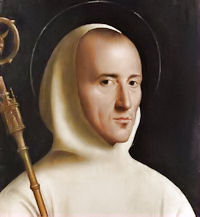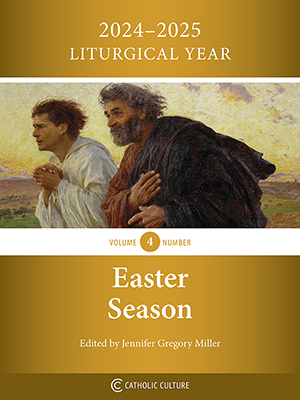Make your gift today!
Help keep Catholics around the world educated and informed.
Already donated? Log in to stop seeing these donation pop-ups.
Easter: April 1st
Tuesday of the Second Week of Easter
Other Commemorations: St. Hugh of Grenoble, Bishop (RM)
» Enjoy our Liturgical Seasons series of e-books!
God loved the world so much that He gave His only Son, so that everyone who believes in Him may not be lost but may have eternal life. For God sent His Son into the world not to condemn the world, but so that through Him the world might be saved. No one who believes in Him will be condemned, but whoever refuses to believe is condemned already, because he has refused to believe in the name of God's only Son.
Meditation
The living water which Jesus says, quenches thirst forever, is the stream of grace, continually flowing from the Sacraments of the Church, from the inexhaustible merits of Christ, which purifies us from sin, extinguishes the fire of evil desires, quiets the thirst for eternal joys, and renders our will fertile in the performance of good works. As often as we receive the holy Sacraments with lively faith in Jesus, and with the ardent desire for His graces, so often do we drink from this stream, to which we are invited by the Church by these words: "You shall draw waters with joy, out of the Savior's fountains" (Is. 12:3). When saying that God is a spirit, who must therefore be adored in spirit and in truth, Jesus rebukes the Jews who, as has been already observed, directed their attention only to the external ceremonies and customs of the Church, and forgot the true conversion of their hearts, as well as the Samaritans who built a temple on Mount Garizim, arbitrarily arranged their form of worship, and frequently mixed it with heathen superstition. The will of His Father, to redeem and sanctify man, was the food of Jesus. So you also let your nourishment be the will of God who requires of you to love Him with all your heart, and to keep His commandments. — The Church's Year by Rev. Fr. Leonard Goffine
St. Hugh of Grenoble (or Châteauneuf)
In the eleventh century the diocese of Grenoble in southeastern France was notorious for corruption. Simony (the buying and selling of spiritual goods), usury, immorality, and ignorance were rampant in that area. During a Church synod at Avignon in 1080, it was decided that a strict bishop should be appointed to correct these abuses; one who could lead both clergy and laity to conform to the laws of the Church. Saint Hugh was unanimously elected to the office.
Hugh was born near Valence in southern France in 1053. After completing his formal education, he accepted a canonry (an official membership in the bishop's council) in the cathedral of that city. In his early twenties, he met the bishop of Die, who was impressed by Hugh's virtue and administrative talents and offered him a position in his own diocese. Hugh accepted the offer and later went with the bishop to the synod at Avignon, where he was unexpectedly elected to the see of Grenoble. After being ordained at the age of twenty-seven, he was consecrated bishop by the pope.
For two years, Hugh preached, fasted, and prayed in an effort to correct the many abuses in his diocese. Then, feeling that a new bishop might be more successful, he resigned and entered the novitiate at the Benedictine abbey of Chaise-Dieu. He was there only a short time when Pope Gregory VII commanded him to return to his see. Once again in Grenoble, Hugh more effectively fought the evils in his diocese. The poor were his greatest concern; once, during a time of famine, he sold his ornate gold chalice to buy them food. In 1084, when Saint Bruno, founder of the Carthusian Order, was looking for a site for a new monastery, Hugh, guided by a dream, granted him the territory known as "the Chartreuse" which gave the order its name. Hugh is often portrayed in art in connection with the Carthusians; he admired the monks and frequently visited them, happily joining in their exercises and performing the most menial tasks.
Throughout his fifty-two years as bishop of Grenoble, Hugh harbored a desire for contemplative life, but because of the tremendous influence of his holiness, pope after pope refused to release him from office. He died after a long illness and was canonized two years later by Pope Innocent II.
—The Lives of the Saints for every day of the year, Vol. 1: January-April
Patronage: against headaches; Grenoble, France
Symbols and Representation: carrying a lantern; one of a group of seven stars, representing the founders of the Carthusians; with Saint Bruno; with three flowers in his hand
Highlights and Things to Do:
- Read more about St. Hugh:
- In 1084 St. Hugh gave to St. Bruno and his six companions the land of La Grande, a desert in his diocese, called the Chartreuse, where they could live in solitude. It was here that St. Bruno founded the Carthusians. The entire name of the Carthusians is "Order of the Chartreuse." The liqueur Chartreuse originates from the Carthusians. Find out the history.
- Find out more about Carthusian monks and see the list of monasteries in the world.






